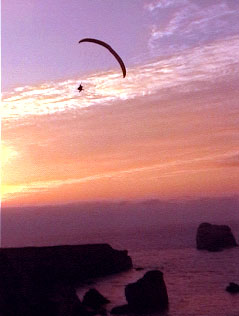1Sky Paragliding FAQ
|
What is a Paraglider?Perhaps we should start with what a paraglider isn't. A parachute is something usefull for jumping out of airplanes and leaping off precipi, and a parasail is a parachute dragged behind a boat like a kite. Skydiving parachutes have evolved into steerable canopies that actually fall slightly forward through the air as opposed to falling straight down. A paper airplane is folded so it also "falls forward" instead of directly down, and thus "glides". A Kite is actually forced to fall upwards against the wind by the kite string, and requires either wind or a fast run to get airborne. Hang Gliders are very similar to a kite with the added benefit that the pilot is able to steer the glider throughout the flight by shifting his or her weight. None of these aircraft are a paraglider, but all form the principles that gives humans flight through modern paragliders A Modern Paraglider is classified by the FAA as a "weight shift hang-glider", and is thus exempt from most all of the FAA's rules and regulations. Technically speaking, a paraglider is a parafoil kite large enough to carry human weight. A similar design on a smaller scale has spawned an entire new sport of kite-surfing. By using the air itself as a pressure to inflate the kite into an airfoil shape, controlled gliding flight can be achieved using the falling weight of the pilot as the "motor". The glider size needed is dependent mostly then on the weight of the pilot, and square meters per kilogram is called wing-loading. Since the paraglider does not have any rigid structure, it can be easily folded into a small roll, then packed into a backpack for easy transport. The earliest paragliding flights where the rewards for a mountain sumit hike, and many prefer to keep the "hike and fly". Computers have helped in the design of modern paragliders, and flights over 200 miles are possible on thermal updrafts with favorable winds. The Bay Area airspace is quite restricted due to SFO and OAK and SJO, but 80 mile flights from Mt. Diablo are contenders for the CA state record, and flights from sunrise to sunset have been logged in the steady coastal airflow. |
How Safe is Paragliding?Statistically speaking, there are less paragliding deaths per year than Horseback riding. An insurance report shows paragliding fatalities/participant to be less than motorcycle riding! Simply put, all adventure sports carry risks. The most important aspects of learning to fly safely are pilot attitude, competent instruction, and safe equipment. Modern paragliders are computer designed to provide optimum safety and stability, but no matter how safe the equipment, launching into a thunderstorm is a very bad idea. Since the air is invisible, pilots must use their skills of observation and imagination to predict the air and its flow. All students will carry a reserve parachute, which has decreased our injury statistics drastically. |
How long do i have to train before i can fly on my own?Everything you need to know about how to setup, launch, fly, and land a paraglider can be taught in about 30 minutes. The same can be said about skiing or snowboarding, but obviously it takes a bit longer before you can handle black diamond slopes!! A Paraglider is an extremely simple aircraft that is easy to fly, but the weather and the wind are not always gentle. On average, it takes 3 days to reach the P1 level, and an additional 7 days (total 10 days) to reach the P2 level. Usually, you'll get your feet off the ground on the first day on the "training hill" |
Do i really need a license?No. You are not required by any laws to be licensed to fly a paraglider in uncontrolled airspace. Since there isn't much uncontrolled airspace in the bay area, most all of the flying sites in the bay area are "regulated". This means that a Hang or Paragliding club has an agreement with the landowner (usually a county park, state lands, or forest) to manage the site and assure that only trained and licensed pilots fly the site. Regardless, it is very recommended that the pilot get training from a USHGA certified instructo.r |
What does it feel like to fly? What about fear of heights?Flying is different for everyone. Some find the adreneline surge of aerobatics to be addictive, while others prefer to meditate while floating high above the serene pacific at sunset. Every day the weather is different, and so most every flight will be different too. A lot of people who are "afraid of heights" really suffer from vertigo, which is a visual perspective distortion. In other words, if you get queasy looking over the edge of a cliff, chances are you will be fine with floating above it. if you've ever dreamt of flying, or like roller coasters or downhill sports, you'll be pleasantly surprised with the ease and beauty of unpowered flight. |
Other Links and Answers |
